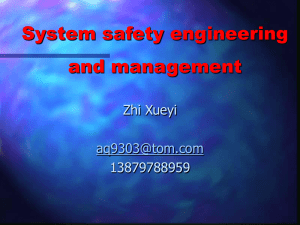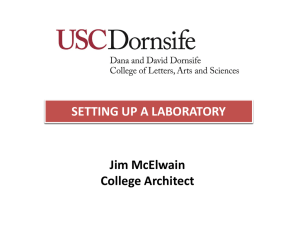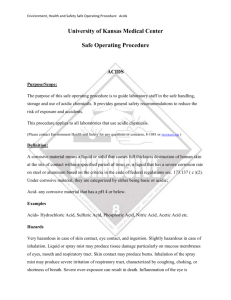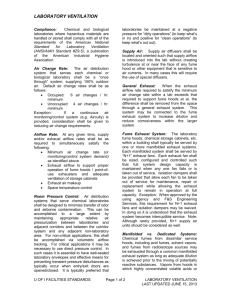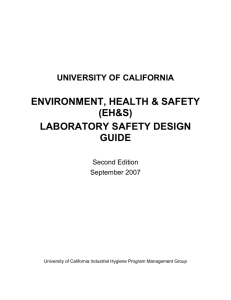Fundamentals of Chemical Laboratory Safety
advertisement
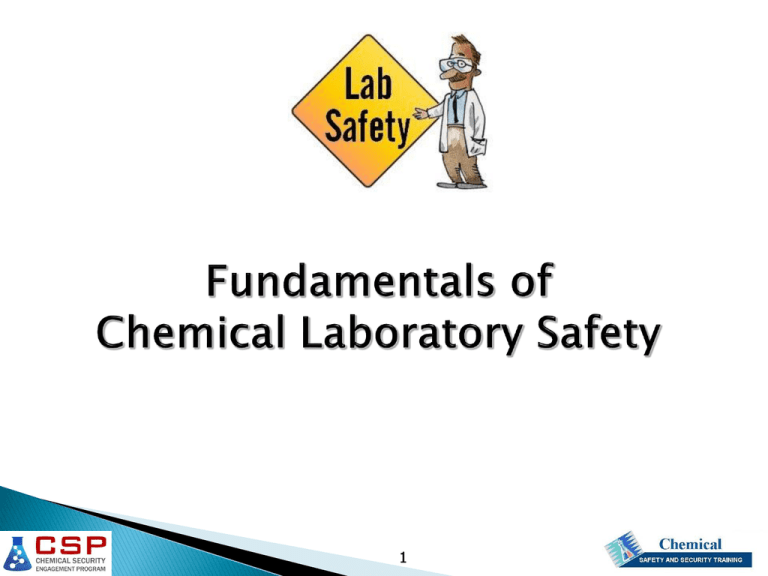
1 “Safety in Academic Laboratories, Vol.1 & 2,” American Chemical Society, Washington DC, 2003, also available online: http://portal.acs.org/portal/acs/corg/content?_nfpb=true& _pageLabel=PP_SUPERARTICLE&node_id=2230&use_sec=f alse&sec_url_var=region1&__uuid=ef91c89e-8b8343e6-bcd0-ff5b9ca0ca33 “Prudent Practices in the Laboratory: Handling and Disposal of Chemicals,” National Academy Press, 1995, also available online: http://www.nap.edu/catalog.php?record_id=4 911 2 3 – The control of exposure to potentially hazardous substances to attain an acceptably low risk of exposure 4 Chemical Laboratory Safety Hazard – the potential to harm Risk – the probability that harm will result 5 Chemical Laboratory Hazards • Chemical hazards – dusts, fumes, mists, vapors, gases • Physical hazards – fire, electrical, radiation, pressure vibration, temperatures, noise • Ergonomic hazards – repetitive motion (pipetting), lifting, work areas (computers, instruments) • Biological hazards – pathogens, blood or body fluids 6 based on the principle of Industrial Hygiene – The anticipation, recognition, evaluation and control of health hazards in the work environment to protect workers health and well-being and to safeguard the community and the environment 7 Chemical Laboratory Safety Industrial Hygiene Principles Anticipation Chemical hazards Recognition Physical hazards Evaluation Ergonomic hazards Control Biological hazards 8 Safety First ! To consider safety in the beginning is: Easier, Cheaper, Safer, … and it saves you time ! 9 Advance Experiment Planning: Outline proposed experiment Acquire safety information (M)SDS, REACH Consult with CSSO? 10 Risk Analysis Which chemicals? How much? Special equipment needed? Who does the work? Staff properly trained? Can the experiment go wrong? Do you have an emergency plan? 11 Types of lab hazards: chemical toxicity fire / explosion physical hazards biohazards radiation special substances 12 What are the anticipated risks? – – – – Are the equipment & facilities adequate? Are staff properly and sufficiently trained? Risks if experiment goes wrong? Is there a plan for this? 13 How are the risks controlled? • Engineering controls: – enclosure / isolation – ventilation / hoods • Emergency Plan • Personal Protective Equipment (PPE) 14 15 Acute (short term, poisons, asthmagens) cyanide strychnine Chronic (long term, carcinogens, reproductive) vinyl chloride (liver cancer) asbestos (mesothelioma, lung cancer) thalidomide (developmental birth defects) 16 Routes of Exposure Breathing Zone Inhalation* Absorption Ingestion Injection *Most important route of entry 17 Eyes 18 Moving unguarded parts, pinches vacuum pump belts Broken glassware and sharps, cuts Pressure apparatus Vacuum containers Dewar flasks High voltage equipment Computer workstations Slips, trips & falls 19 Blood borne pathogens AIDS, HIV, hepatitis, clinical chemistry labs Recombinant DNA Genetic engineering, cloning Work with animals Zoonoses, diseases from animals 20 Ionizing Radiation: alpha a, beta b, gamma g, X-rays, neutrons Radioactive isotopes: tritium, H-3, carbon, C-14, sulfur, S-35,phosphorus, P32/33, iodine, I-135 21 Non-Ionizing Radiation: Ultraviolet (UV spectrometers) Magnetic (NMR, MRI) Microwave (Heart pacemaker hazard) Lasers (eye protection required) 22 Controlled Substances: regulated drugs, psychotropic (hallucinogenic) substances, heroin Highly Toxic Chemicals: nerve gas, phosgene, riot control agents, chemical warfare agents 23 – Administrative practices organizational policies – Operational practices work practices – Engineering controls ventilation, barriers 24 organizational safety policies that apply to everyone 25 Have a Safety Manual Never work alone, especially after hours. Specify when eye protection & PPE is required. Specify operations that require hood use. Specify required training. No mouth pipetting. No long hair or dangling attire. 26 No eating, drinking, smoking in laboratories Label all chemical containers Label refrigerators, No Food Label explosion safe refrigerators Require periodic fire drills 27 Safe Laboratory Procedures: Packages opened only in labs, not receiving Receiving staff trained to look for signs of breakage and/or leaking shipments Receiving area has spill kits Mailroom/receiving alert for suspicious shipments 28 Use hoods properly: - Work 6” (15 cm) in from sash - In center of hood - Work with hood sash at ~18” (45 cm) high - Close sash when not in use - Don’t use for storage 29 SOURCE RECEIVER 30 Engineering Controls 1. Change the process eliminate the hazard 2. Substitution non-hazardous substance for hazardous (e.g. - toluene for benzene) 31 Engineering Controls 3. Isolate or enclose the process or worker Use a barrier 4. Ventilation Dilution (general ventilation) - Not good Local exhaust ventilation (LEV) - Preferred 32 Engineering Controls Properly functioning & used correctly! Laboratory hoods and ventilation are the basis of engineering controls. 33 Must be used and maintained properly. 34 Engineering Controls Local exhaust ventilation includes: snorkels 35 Local exhaust ventilation includes: vented enclosures 36 Engineering Controls Local exhaust includes: special containment devices (e.g. - glove boxes) 37 Engineering Controls Local exhaust includes: special containment devices (e.g. - isolation chambers) 38 Hood exhaust should not be blocked or deflected downward, but should exhaust straight up 39 PPE includes: eye protection, gloves, laboratory coats. etc., respirators, appropriate foot protection 40 Have routine, unannounced evacuation drills. Designate a person for each area to ensure that inner rooms are evacuated. Locate outside staging areas at sufficient distance from the building. Test and maintain alarms. Post a person to meet/direct emergency vehicles. 41 Post each room with: Emergency phone numbers After hour phone numbers Person(s) to be contacted Alternate person(s) Unique procedures to be followed 42





